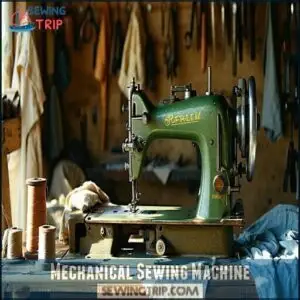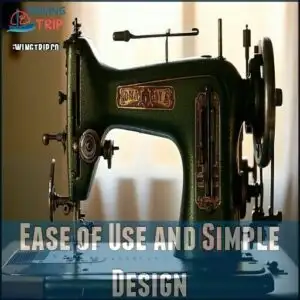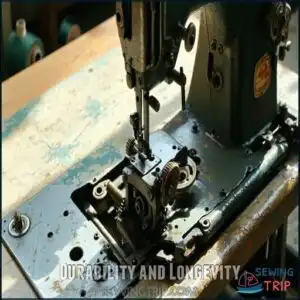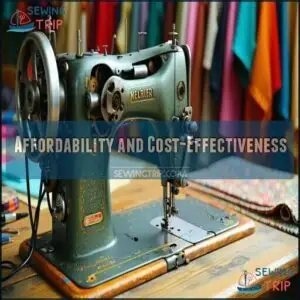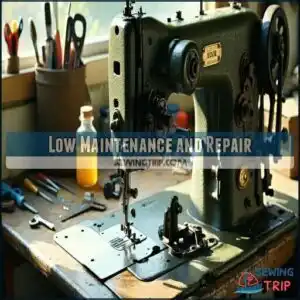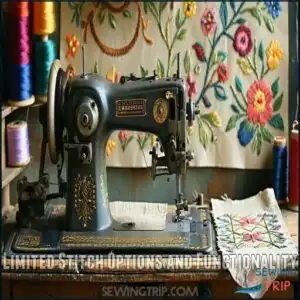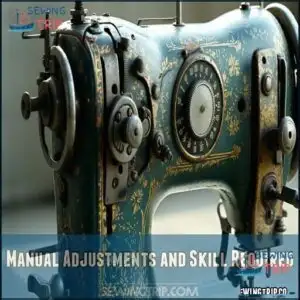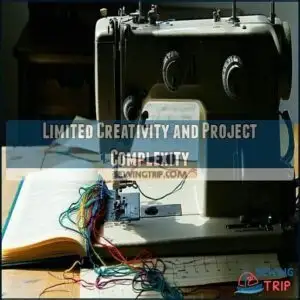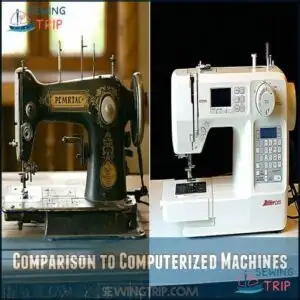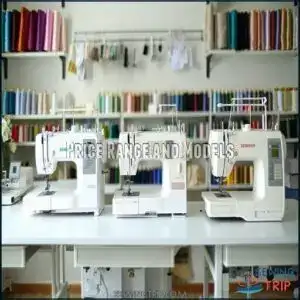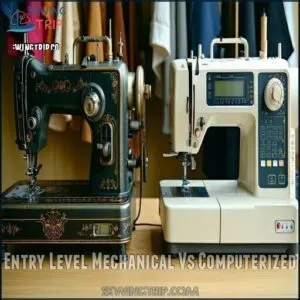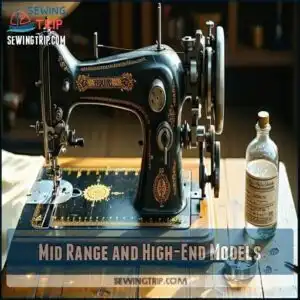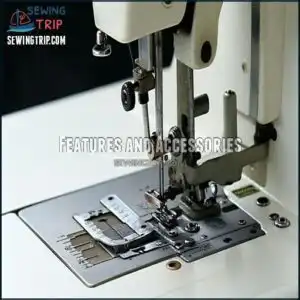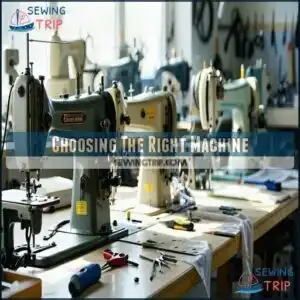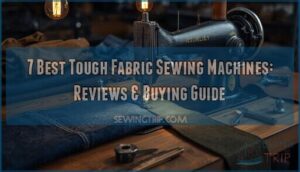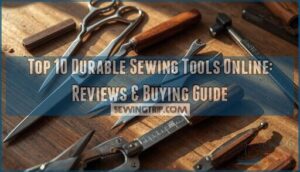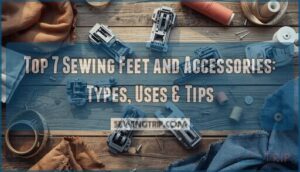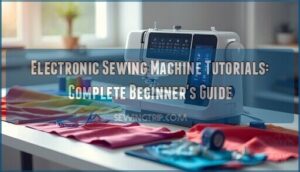This site is supported by our readers. We may earn a commission, at no cost to you, if you purchase through links.
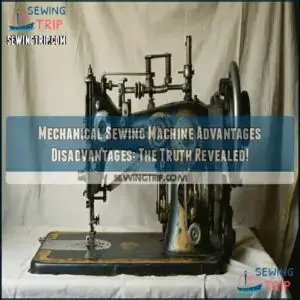
Their advantages include ease of use, affordability, and durability, making them perfect for beginners or those who prefer hands-on control.
They’re low-maintenance and don’t require software updates or fancy touchscreens.
However, they come with trade-offs, including limited stitch options and the need to make manual adjustments, which might make them less suited for complex or creative projects.
If you’re all about precision or tackling intricate designs, you might feel restricted, but for straightforward sewing, they’re hard to beat.
Ready to weigh your options?
Table Of Contents
Key Takeaways
- You’ll love mechanical sewing machines for their durability, affordability, and ease of use, making them perfect for beginners and straightforward projects.
- They’re low-maintenance and simple to repair, with fewer parts that can malfunction compared to computerized models.
- Limited stitch options and manual adjustments can feel restrictive, especially for intricate or creative projects.
- Mechanical machines excel at handling thick fabrics and basic tasks but might require more skill to master manual adjustments.
Mechanical Sewing Machine
You’ll find mechanical sewing machines operate through manual dials that control stitch width, length, and tension, giving you hands-on control without digital interfaces.
They’re known for their durability and simplicity, making them perfect for beginners who want reliability without the learning curve of computerized features.
Definition and Overview
A mechanical sewing machine is your hands-on, traditional workhorse that operates without computerized components.
You’ll control everything manually through dials and levers, making it perfect for sewing basics and straightforward projects.
Five key aspects of mechanical sewing machines:
- Core functionality focused on essential stitches
- Simple internal mechanisms powered by manual operation
- Historical context dating back to the machine evolution of the 19th century
- Target users include beginners and traditionalists
- Minimal electronics, maximum durability
The combination of these aspects makes mechanical sewing machines ideal for those who prefer a more hands-on approach to sewing.
Notable Mechanical Sewing Machine Brands
Now that you understand what mechanical sewing machines are, let’s look at who makes the best ones.
Singer offers heavy-duty models like the 4432, showcasing Singer’s Legacy of durability.
Brother Simplicity shines in their beginner-friendly designs that grow with your skills.
Janome Reliability is legendary with models like the HD3000.
Husqvarna Viking provides workhorse machines with educational features, while Bernette offers incredible speed at 1,100 stitches per minute.
These brands reflect the evolution of sewing over decades.
Key Features and Components
Now that you’ve explored those trusted brands, let’s look at what makes mechanical sewing machines tick.
Your mechanical sewing machine consists of several essential parts working together to create reliable stitches.
- The tension system controls thread tightness for perfect seams
- A feed mechanism moves fabric smoothly under the needle
- The bobbin winding system prepares thread for the underside stitching
These durable components form the backbone of every mechanical sewing machine, offering straightforward operation with fewer things to go wrong.
Advantages of Mechanical Machines
You’ll appreciate mechanical sewing machines for their straightforward operation, exceptional durability, budget-friendly price point, and minimal maintenance requirements.
Straightforward, durable, and budget-friendly, mechanical sewing machines deliver reliability with minimal maintenance—perfect for beginners and traditionalists alike.
These reliable workhorses offer you hands-on control with simple dials for adjustments, saving you money while providing decades of faithful service when properly cared for, making them a great value for their budget-friendly price point.
Ease of Use and Simple Design
Simplicity shines in a mechanical sewing machine’s straightforward design.
You’ll appreciate the intuitive operation with clearly marked dials for quick adjustments.
Unlike computerized counterparts, manual control doesn’t require technical know-how—perfect for beginner friendliness.
Just turn the dial, thread the needle, and you’re ready for basic sewing.
Many sewists find this simple sewing machine design refreshingly accessible—no need to decode complex digital menus when you’re keen to start stitching!
Durability and Longevity
Now that you’ve got the basics down, you’ll appreciate the legendary staying power of mechanical sewing machines. These workhorses are built to last decades—not years—with proper care.
- Cast metal frames that withstand daily sewing stress
- Steel gears that maintain precision through thousands of projects
- Minimal electronic components to malfunction
- Serviceable parts that can be easily replaced
- Simple mechanisms that continue operating even with minor wear
Your mechanical sewing machine’s durability and reliability come from its straightforward design. They also offer simplicity and durability, making them a reliable choice for many users. Regular oiling impacts lifespan substantially, while usage intensity affects repair frequency less than with computerized models.
Affordability and Cost-Effectiveness
You’ll appreciate the significant cost advantages of mechanical sewing machines compared to their computerized counterparts.
With prices starting around ₹4,000 (while computerized models begin at ₹12,000), they’re ideal for budget sewing enthusiasts.
Your initial beginner investment stretches further, offering excellent long-term value despite fewer features.
The affordable sewing machine market features reliable brands like Usha, providing cost-effective options without sacrificing essential functionality.
For cost comparison, mechanical machines consistently win on price-to-durability ratio.
Low Maintenance and Repair
Mechanics of a traditional sewing machine make DIY repairs a breeze compared to their computerized cousins.
You’ll find maintenance invigoratingly straightforward with fewer components that can malfunction.
Consider these maintenance advantages:
- Simple oiling frequency requirements keep your machine running smoothly
- Basic tools handle most common issues without professional help
- Wide part availability makes repairs affordable when needed
Your mechanical machine won’t require extensive technical knowledge for long-term care, and the overall process is quite straightforward with simple maintenance tasks, making it invigoratingly easy to manage.
Disadvantages of Mechanical Machines
You’ll face some trade-offs with mechanical sewing machines, including limited stitch options and the need for manual adjustments that require more skill to master.
While these machines excel in durability and affordability, they can restrict your creative potential when tackling complex projects that would benefit from the automated features found in computerized alternatives, which can be a significant trade-off.
Limited Stitch Options and Functionality
While mechanical sewing machines shine in durability, they do fall short in terms of stitch variety.
You’ll typically find only 10-15 basic stitches compared to computerized machines’ 100+ options.
This limitation can restrict your creative freedom on complex projects like quilting or embroidery.
The functional disadvantages become apparent when you need specialized stitches for specific fabrics or techniques, and your project suitability may be compromised when facing these stitch limitations.
Manual Adjustments and Skill Required
While basic stitches are accessible, mechanical sewing machines demand more skill for perfect results.
You’ll need to manually adjust tension, stitch length, and width with dials that can be finicky, which builds valuable precision control.
This hands-on experience is rewarding but initially frustrating, similar to learning to drive stick-shift—it’s a process that requires patience and practice.
Many beginners find themselves rethreading or adjusting bobbins repeatedly before mastering these manual adjustments, which can be a learning curve that tests their persistence and dedication.
Limited Creativity and Project Complexity
Most mechanical sewing machines restrict your creative potential due to their limited stitch variety.
You’ll face project limitations when attempting intricate designs that require specialized stitches beyond basic straight and zigzag options.
While simplicity has its charm, these design constraints can frustrate you when tackling complex quilting or decorative work.
However, these limitations do encourage skill development as you’ll learn creative workarounds and improve fabric handling techniques despite the machine’s inherent restrictions, which can be a valuable aspect of working with basic straight and zigzag options.
Comparison to Computerized Machines
In stark contrast to their computerized counterparts, mechanical sewing machines offer substantially fewer bells and whistles. You’ll notice the difference immediately when comparing their manual controls to the automation level of modern machines.
- Stitch variety is limited to basics, while computerized models offer hundreds of options
- Learning curve focuses on physical skill rather than technical understanding
- Project suitability narrows with mechanical models, making complex designs challenging
Despite their charm, mechanical machines simply can’t match the versatility of computerized options for advanced projects, which is a significant limitation for users who want to create complex designs.
Price Range and Models
While comparing machines showed functionality differences, your budget will greatly influence which mechanical sewing machine you can bring home.
Let’s examine the price landscape:
| Price Range | Models | Features | Lifespan |
|---|---|---|---|
| Entry-level ($120-$200) | Singer M1500, Janome Cat Fancy | Basic stitches, manual threading | 5-10 years |
| Mid-range ($200-$600) | Brother HC1850, Viking Onyx 25 | More stitches, better tension | 10-15 years |
| High-end ($600+) | Pfaff Select 4.2, Janome 3160QDC-T | Premium construction, smoother operation | 15+ years |
To get an idea of what’s available, you can easily research current sewing machine costs to find the best sewing machine for your needs, considering factors like lifespan and features.
Entry Level Mechanical Vs Computerized
While entry-level machines differ substantially in price point, the learning curve tells an interesting story.
You’ll find mechanical sewing machines easier to operate, often providing essential stitches with just one or two dials. They’re ideal if you’re just starting your sewing journey without a hefty initial investment.
Computerized models offer touchscreens and hundreds of stitches, but beginners who sew occasionally might find a simple mechanical machine more efficient than mastering computerized features.
Some users prefer the simplicity of mechanical options.
Mid Range and High-End Models
Mid-range and high-end mechanical sewing machines balance affordability and durability but lack advanced features.
While their build quality guarantees reliability, the limited stitch options can restrict project suitability.
Accessories often cost extra, making investment justification tricky, and brand comparison reveals some models excel in performance.
Still, their longevity remains a key sewing machine advantage, and many sewers seek to purchase a model for home use, considering the need for regular maintenance like oiling.
Features and Accessories
Mechanical sewing machines keep things simple, but simplicity comes with fewer accessories.
You’ll often find:
- Basic presser feet and stitch plates, limiting versatility.
- Standard bobbin systems, lacking advanced features.
- No automatic needle threaders or oiling systems.
While these machines are durable and reliable, their minimal features can feel restrictive, especially when compared to computerized models brimming with modern conveniences.
These models use physical knobs, while electronic sewing machines use digital displays.
Choosing The Right Machine
Choosing the right sewing machine depends on your experience, project goals, and budget. Whether you’re after simplicity or advanced features, understanding your needs will make the decision much easier.
Considerations for Beginners
If you’re new to sewing, a mechanical sewing machine is a great starting point.
Its simplicity reduces the learning curve, making it a beginner sewing machine that’s easy to master.
Maintenance simplicity and affordability are key sewing machine advantages, especially with budget constraints.
While project suitability might be limited, it’s perfect for skill development without overwhelming features.
Factors for Experienced Sewers
For experienced sewers, a mechanical sewing machine offers unmatched Precision Control and Stitch Consistency, especially on heavy fabrics.
Its hands-on approach guarantees reliable fabric handling but may feel restrictive for complex designs.
While its durability is a clear advantage, Creative Limitations can arise for intricate projects.
Regular maintenance helps avoid troubleshooting common issues.
Still, for straightforward tasks, it remains a durable sewing machine with excellent Project Versatility.
Evaluating Budget and Needs
When evaluating your budget and needs, consider these factors for a mechanical sewing machine:
- Budget Prioritization: Start with what you can afford without overspending.
- Skill Level: Beginners might prefer simplicity over advanced features.
- Project Scope: Match the machine’s capabilities to your sewing goals.
- Future Needs: Plan for potential skill growth.
- Repair Costs: Mechanical machines are cheaper to fix long-term.
Mechanical Vs Computerized for Specific Projects
For garment construction or heavy-duty tasks, a mechanical sewing machine shines with its durability and simplicity.
However, a computerized sewing machine excels in embroidery options, quilting projects, and intricate home decor designs, thanks to its advanced features.
Each has advantages and disadvantages, so match the machine to your sewing projects—simple or complex—to get the best results.
Frequently Asked Questions (FAQs)
Are mechanical sewing machines better?
It depends on your needs.
Mechanical sewing machines shine for simplicity, durability, and affordability.
They’re great for basic tasks and heavy fabrics, but lack advanced features, making them less ideal for creative or complex projects.
What are the disadvantages of a computerized sewing machine?
Computerized sewing machines can overwhelm you with their digital interfaces and countless features.
They’re pricier, harder to repair, and demand tech-savviness.
Plus, their durability often falls short compared to simpler, mechanical alternatives for long-term use, which can be a significant drawback for those seeking durability.
Do mechanical sewing machines last longer?
A mechanical sewing machine is like a trusty old friend—it’s built to last.
With fewer electronic parts, it’s less prone to breakdowns, and with proper care, it can easily serve you for decades.
What are the advantages and disadvantages of a sewing machine?
A sewing machine’s advantages include efficiency, precision, and versatility for various projects.
Disadvantages can be cost, complexity for beginners, and maintenance needs.
Choosing wisely guarantees you get a reliable ally for creative or practical tasks.
How do mechanical sewing machines handle thick fabrics?
Tackling thick fabrics with a mechanical sewing machine is like driving an old truck—sturdy and reliable.
With proper tension adjustments, a strong needle, and smooth feeding, it handles denim or canvas like it’s no big deal, making it a reliable tool for sewing thick fabrics.
Can mechanical machines sew lightweight or delicate materials?
You can sew lightweight or delicate fabrics with a mechanical machine, but you’ll need to adjust tension and use the right needle and thread.
Practice on scraps first to avoid puckering or damage.
What are common troubleshooting tips for mechanical machines?
Imagine your stitches skipping mid-project—frustrating, right?
First, rethread the machine and check the needle’s sharpness.
Clean lint from the bobbin area, oil the machine, and make certain proper tension settings for smooth sewing.
Are vintage mechanical sewing machines worth buying?
Vintage mechanical sewing machines are absolutely worth buying if you value durability, simplicity, and charm.
They’re built to last, often outlasting modern models, and can handle heavy fabrics effortlessly.
Plus, they’re repairable with basic tools!
How to properly store a mechanical sewing machine?
Store your mechanical sewing machine in a dry, dust-free area.
Use a cover to protect it from debris, avoid damp spaces to prevent rust.
Occasionally oil key parts to keep it running smoothly.
Conclusion
Sometimes, it’s funny how the simplest tools can be the most dependable.
A mechanical sewing machine offers clear advantages like durability, affordability, and ease of use, making it ideal for straightforward sewing tasks.
Yet, its disadvantages—limited stitch options and manual adjustments—might feel restrictive for intricate or creative projects.
Ultimately, the choice depends on your needs, and if you value hands-on control over bells and whistles, a mechanical sewing machine could be your perfect match, offering a great balance of simplicity and ease of use.

